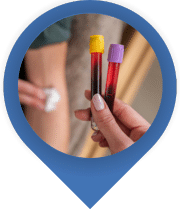The Latest Healthcare News
Check out our blog to learn more from our team about the latest medical advancements, health tips, and primary care news.

Are you experiencing itchy toes and blisters in between them? Chances are you’ve got a case of tinea pedis, or as it’s more commonly called, athlete’s foot. Athlete’s foot is caused by ringworm, which is a fungal infection. While it usually starts between the toes, it can affect other parts of your feet, even spreading to your toenails and the soles of your feet. Symptoms are typically worse at night and when you remove your shoes and socks. For some, the discomfort may affect daily activities, including walking, exercising, and even sleeping.
At AllCare, our dedicated experts can provide a proper diagnosis and treatment plan to help relieve your athlete’s foot infection, prioritizing your comfort and well-being at every stage of your journey.
Contrary to the name, you don’t have to be an athlete to get athlete’s foot. The name comes from the fact that it’s usually found in places athletes are, like locker rooms, swimming pools, and public places. Athlete’s foot is a very common, highly contagious condition that can affect anyone exposed to the fungus, but it seems more prevalent in men and people over 60.
If you suspect you have athlete’s foot, the AllCare expert team of physicians can help diagnose your symptoms, as athlete’s foot can sometimes be mistaken for eczema, psoriasis, and other conditions that cause foot rashes. We’ll determine the cause of your rash and create a personalized plan to help relieve your athlete’s foot symptoms.
Several different fungi in the dermatophyte’s family cause athlete’s foot. These fungi can also cause ringworm and jock itch. Athlete’s foot is often spread through contact in public places used by large groups of people and through contact with an infected surface. Sharing towels, socks, or shoes with someone who has the condition can also spread the fungus. It also thrives in warm, moist environments, such as closed shoes, which can trap sweat and moisture, allowing the fungus to grow uncontrollably.

There are several types of athlete’s foot infections, depending on where your infection is, including:

One of our immediate care physicians will review your medical history and discuss your symptoms, including your overall health and wellness. We’ll then examine your foot to determine if you need further testing.

To identify the fungus causing your rash, we may perform a skin sample test, where a small portion is scraped and examined under a microscope, with results usually available the next day. A skin culture can also be grown in a lab to determine the exact strain, though it takes up to three weeks. Alternatively, a skin biopsy may be done to rule out other skin diseases or cancers that could mimic athlete’s foot.

AllCare will offer education for athlete’s foot self-care that will help clear your current infection and prevent a possible reoccurrence. Education may include how to prevent athlete’s foot, hygiene tips, and when to return for a follow-up or get a referral to one of our primary care physicians.

AllCare physicians may direct you to use over-the-counter (OTC) products for your athlete’s foot. If they don’t work, we may order athlete’s foot medication, including athlete’s foot cream, or stronger creams, ointments, or gels. In the case of a vesicular infection and ulcerative infection, we may also order antibiotics to kill the bacteria. Be sure to follow all instructions carefully.

Experience the convenience of telehealth appointments at AllCare. Our telemedicine services are designed to provide you with seamless access to healthcare without the need to leave your home. Whether you need an online doctor’s appointment for immediate or primary care, AllCare’s got you covered. With our online telehealth services currently available to individuals located in Virginia, Maryland, and Washington, D.C., you can connect with our experienced immediate and primary care physicians via secure video calls.
At AllCare, we are expanding our virtual healthcare access to all services previously offered in person. This includes:
Anyone who is experiencing signs of athlete’s foot can benefit from our athlete’s foot treatment and services. Our experienced team can develop a personalized treatment plan to relieve athlete’s foot symptoms, helping you get the care and support you need as quickly as possible.
We know how uncomfortable, painful, and irritating and you want to resolve your symptoms as quickly as possible. AllCare makes it convenient to get the diagnosis, treatment, and comprehensive care you need, simply by scheduling an appointment or visiting one of our immediate care centers.
Yes, athlete’s foot is contagious and can spread from person to person through contact with an infected person or surface. It can also spread to other parts of the body if someone touches the affected foot and another part of their body, like the hands.
While some over-the-counter medicines may relieve your athlete’s foot symptoms, it’s always a good practice to see your doctor to ensure you actually have athlete’s foot and not another skin condition that may mimic the same symptoms. Be sure to seek medical attention if you experience any of the following:
While athlete’s foot isn’t dangerous, it won’t go away unless it’s treated with an antifungal medication. Untreated, athlete’s foot has the potential to spread beyond your feet to other parts of your body, including your toenails, hands, and groin. This spread can result in more widespread infections, which might require more extensive foot fungus treatment and could complicate the healing process.
Athlete’s foot shouldn’t stop you from working out, but you should take precautions. Including wearing cotton socks or shoes in changing rooms and be sure to always clean and dry your feet afterward and wash your socks in hot water as an added precaution. You should avoid swimming until your infection is clear to reduce the risk of spreading it.
There are some steps to take to reduce your risk of getting athlete’s foot, including:
If you were wondering, yes, an athlete’s foot can be effectively cured with proper treatment. The condition is caused by a fungal infection, and several approaches can help eradicate it. By adhering to the mentioned treatments and preventive measures, athlete’s foot can be cured, and recurrence can be minimized. If over-the-counter treatments are ineffective or if the infection is severe, consult a healthcare provider for further evaluation and treatment.
At AllCare, we’re proud to deliver exceptional primary and immediate care to residents across Virginia, Maryland, and Washington D.C. From bustling city centers to serene suburban neighborhoods, our clinics are strategically placed for your convenience and care. Experience top-tier athlete’s foot treatment in your community with AllCare, where your health is our priority.
Check out our blog to learn more from our team about the latest medical advancements, health tips, and primary care news.
Seasonal Affective Disorder (SAD) represents a significant mental health concern affecting approximately 5% of adults in the United States. This […]
Read More >Mammograms save lives. Early detection of breast cancer through proper screening will give a patient a remarkable 99% five-year survival […]
Read More >Most people are aware that diet, exercise, and genetics affect cholesterol levels. But can stress raise your cholesterol? The answer […]
Read More >Our related healthcare services extend beyond immediate care to include preventive care such as routine physical exams, chronic disease management for conditions like diabetes, and specialty care referrals for more complex health issues.